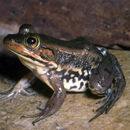Description
provided by AmphibiaWeb articles
Snout-vent lengths are about 50 mm in adults. The dorsum is brownish, marked with darker brown markings, and has four light golden-brown stripes. Two are dorsolateral and two are lateral. Ventral sufaces are either white are pale yellowish, variably mottled with light to dark brown markings that are heaviest on the hind legs. Males have paired external vocal sacs at the angle of the jaws as well as a slightly larger tympana. R. virgatipes has a call made up of a loud, staccato double note which is repeated 3 to 5 times in rapid succession, with a 180 to 400 cycles per second frequency range.
Gosner, K. L. and Black, I. H. (1963). ''Rana virgatipes (Cope). Carpenter Frog.'' Catalogue of American Amphibians and Reptiles. American Society of Ichthyologists and Herpetologists, 67.1-67.2.
- author
- Franziska Sandmeier
Distribution and Habitat
provided by AmphibiaWeb articles
R. virgatipes is found in the Atlantic coastal plain from central New Jersey to the extreme southeast of Georgia. It may be common in the areas in which it occurs, but its distribution is not continuous.Adults live in sphagnum bog pools, small ponds, and the borders of quite streams. In New Jersey it is confined to such habitat in the pine barrens. Adults are found on the water's edge and more commonly seen resting on partially submerged logs or among vegetation.
- author
- Franziska Sandmeier
Life History, Abundance, Activity, and Special Behaviors
provided by AmphibiaWeb articles
Eggs are laid in subspherical or elongate globular masses, ranging in size from 25 by 50 mm to 65 by 100 mm, that are attached to vegetation at the level of the water surface or down to about a foot below it. The larvae are brown with a lighter tail musculature and are irregularly and indistincly spotted or mottled with lighter tones and dotted with black. The margins of the tail fins and especially of the dorsal fin have dark blotches. There are also two lateral dark stripes or rows of spots on the tail musculature and fins, with the lower stripe extending along the midlateral line of the tail musculature before curving upward to meet the dorsal margin of the musculature beyond its midpoint. The upper stripe starts at the point of origin of the dorsal fin, parallels the curve of the lower stripe, turns up into the fin, and extends along about two thirds of the tail.
- author
- Franziska Sandmeier

